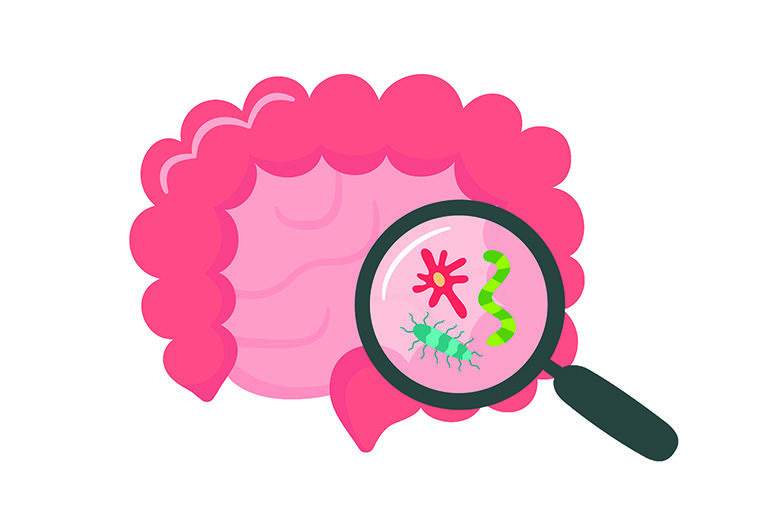
Small intestinal bacterial overgrowth, or SIBO, is a condition caused by increased numbers of bacteria in the small intestine. The understanding of SIBO continues to evolve with increasing data about the human microbiome. While there is no one specific diet for people with SIBO, registered dietitian nutritionists can work with patients or clients to create individualized eating plans that help relieve symptoms.
How It Happens
Normally, the small intestine contains very little bacteria; the concentration of microbes increases progressively down the small bowel to the colon, where approximately 38 trillion microbes live. With SIBO, bacteria are displaced from the colon, increasing the number and types of microbes in the small intestine and causing excess fermentation, malabsorption or inflammation.
SIBO is a secondary condition, meaning it occurs in response to something else, such as a disease or alteration to the small bowel. There are several reasons SIBO may develop: Post-surgical causes may include resections or anastomotic adhesions or strictures. Medications can contribute; for instance, opioids slow the bowel and anticholinergics alter gastric acid production. Structural causes may include diverticula of the small intestine or fibrous bands. Additionally, small intestine function can be altered by chronic inflammatory diseases, such as lupus, diabetes or chronic pancreatitis.
Any of these factors can disrupt the mechanisms that keep the small intestine “clean” and introduce bacteria that normally wouldn’t be there. Innate cleaning mechanisms of the small intestine include secretion of stomach acid, pancreatic excretions and the migrating motor complex, a cyclical four-stage process that occurs during fasting and includes contractions, which push residual food to the colon. Additionally, the ileocecal valve keeps out unwanted microbes by blocking the connection between the colon and the small intestine.
Symptoms
Symptoms associated with SIBO may include abdominal distention and bloating. Abdominal distention grows progressively worse throughout the day and is usually worst in the evening. Abdominal pain or discomfort also is common, though intense pain is not usually associated with SIBO. Feeling full quickly, “brain fog” or fatigue, especially after eating, are other possible signs of SIBO. While weight loss has long been a symptom associated with SIBO, weight gain is now a recognized symptom as well. People with SIBO also may experience nausea, diarrhea or constipation (which can occur depending on the type of overgrowth present).
SIBO or IBS?
RDNs may encounter SIBO in the context of irritable bowel syndrome, as many of the symptoms overlap. Although data varies on the prevalence of SIBO in people with IBS, a recent meta-analysis reviewed 25 case-controlled studies with more than 3,000 IBS patients and 3,000 controls without IBS. Researchers found the prevalence of SIBO in subjects with IBS was 31% and only 9% in the control group, meaning people with IBS are more likely to have SIBO. Another study found that SIBO was more prevalent in IBS patients with diarrhea than those with constipation.
Dietary Interventions
RDNs can guide patients and clients on how to best manage symptoms through diet modifications. Though many diet therapies have been suggested — such as the Specific Carbohydrate Diet, SIBO Bi-Phasic Diet, Gut & Psychology Syndrome Diet, low FODMAP diet and Cedars-Sinai Low Fermentation diet — evidence is lacking on whether any of these diets is best for someone with SIBO.
In February 2020, the American College of Gastroenterology released clinical guidelines for SIBO. They recommend eating fewer fermentable foods, including “alcohol sugars and other fermentable sweeteners such as sucralose.” Additionally, the guidelines suggest reducing fiber consumption and avoiding prebiotics such as inulin.
Some practitioners suggest incorporating meal spacing, which means waiting at least five hours between meals to allow as much time as possible for the migrating motor complex to occur. This gives more time for contractions to push residual food and bacteria through the small intestine to the colon.
Key nutritional concerns of SIBO include reduced fat absorption and, consequently, fat-soluble vitamin deficiencies as well as iron, thiamin and B12 deficiencies. There is not enough evidence to support the use of probiotics in people with SIBO, and some studies suggest probiotics may worsen symptoms.
After a physician’s diagnosis, RDNs should first consider removing fermentable carbohydrates from the patient’s or client’s diet, then reintroducing them as tolerated to create an individualized eating plan that can be maintained over the long term. Consider trialing meal spacing and be mindful of potential nutrient deficiencies.
Additionally, practicing a multidisciplinary approach can lead to better overall care. This means working alongside a patient’s or client’s gastroenterologist, primary care physician and any other health care professionals. Working as a team can create seamless care and encourage patients and clients to follow nutrition recommendations for best management of their symptoms.
Learn more about the testing for SIBO, diagnostic criteria and the rate of recurrence, plus discover the three pillars of management — including considerations for an elemental diet — by watching the 2021 Food & Nutrition Conference & Expo™ session Diagnosis, Treatment and Dietary Interventions for Small Intestinal Bacterial Overgrowth: An Up-To-Date Practical Review.
References
Anastomotic Stenosis (Stricture) After Gastric Bypass Surgery. University of Rochester Medical Center website. https://www.urmc.rochester.edu/encyclopedia/content.aspx?contenttypeid=134&contentid=155. Accessed November 22, 2021.
Anticholinergic Agents. LiverTox: Clinical and Research Information on Drug-Induced Liver Injury. National Institute of Diabetes and Digestive and Kidney Diseases. Bethesda(MD); 2017.
Deloose E, Janssen P, Depoortere I, Tack J. The migrating motor complex: control mechanisms and its role in health and disease. Nat Rev Gastroenterol Hepatol. 2012;9(5):271-285. Published March 27, 2012.
Fogt E, Hardy A, Rezaie A. Diagnosis, Treatment and Dietary Interventions for Small Intestinal Bacterial Overgrowth: An Up-To-Date Practical Review. Food & Nutrition Conference & Expo™ session. Presented October 18, 2021.
Pimentel M, Saad R, Long M, Rao S. Clinical Guideline: Small Intestinal Bacterial Overgrowth. Am J Gastroenterol. 2020(115)(2);165-178.
Rao SSC, Bhagatwala J. Small Intestinal Bacterial Overgrowth: Clinical Features and Therapeutic Management. Clin Transl Gastroenterol. 2019;10(10):e00078.
Sizar O, Genova R, Gupta M. Opioid Induced Constipation. StatPearls Publishing. Treasure Island(FL); 2021.
Takakura W, Pimentel M. Small Intestinal Bacterial Overgrowth and Irritable Bowel Syndrome – An Update. Front Psychiatry. 2020;11:664.
